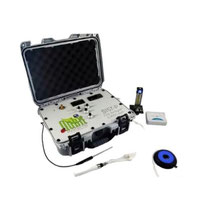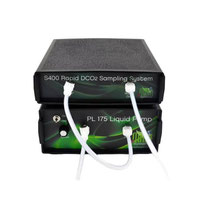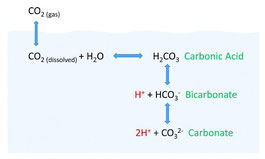Dissolved CO2 (DCO2) Analysis Systems

Dissolved CO2 Systems (Q-DCO2). Dissolved CO2 (DCO2) Systems measure dissolved pCO2 in water under atmospheric pressure conditions. Systems consist of a DCO2 sampler along with accessories, a non-dispersive infrared CO2 analyser with built-in gas pump, a data interface, and accompanying software. The Rapid Response DCO2-RR System, an extension of the system, features in addition a flow-through Rapid Response Dissolved CO2 sampling system, and a liquid pump.
DCO2 System, Standard Configuration

The pivotal component in the standard system (Q-DCO2-ST) is the DCO2 sampler Q-S350, responsible for sampling pCO2 from the liquid and transporting it to the IRGA. Encased in a PTFE (polytetrafluoroethylene) membrane, the DCO2 sampler can be submerged in water up to ~60 cm (2 feet). The dissolved CO2 in water diffuses through the PTFE membrane into the sampler, where it is conveyed to the CO2 analyser through a closed-loop fixed volume gas stream for detection. Successful operation of the system requires liquid flow past the sampler, and stirring is essential for optimal performance. The PTFE membrane is permeable to gases, but impermeable to water at atmospheric pressure. This system specifically detects the dissolved partial pressure of CO2 in water and is insensitive to carbonates (see figure below). It's important to note that this method of determining CO2 partial pressure does not rely on pH measurements. DCO2 systems can be adapted to a range of CO2 concentrations from ppm to 100% in the gas phase. The standard DCO2-ST system has a response time of 4–10 minutes due to the diffusion process across the PTFE membrane. The speed of response is dependent on the flow of liquid past the DCO2 sampler, emphasising the need to stir the solution thoroughly. Applications include ocean acidification studies, fermentation studies, algae cultivation and other bioreactors, aquaculture, environmental monitoring, waste water management, food and beverage industry, etc.
Rapid Response Dissolved CO2 System

Alternatively, a Rapid Response System (Q-DCO2-RR) with a flow-through design is available. This variant employs the DCO2 sampling system, where water circulates through silicone tubes, and gas passes on the opposite side of the tubules in the reverse direction. CO2 gas then diffuses across the tubes from water to the gas stream, ultimately reaching the CO2 sensor for precise measurements. In contrast to the standard DCO2-ST system (described above), the Rapid DCO2-RR flow-through system has a different sampler (Q-S400) and a water pump (Q-PL175), and thus in sum a fast response time of 2–4 minutes. This extends the applications mentioned above to e.g. aquatic animal respirometry.
Q-DCO2 Systems - Features
- Measurement of dissolved CO2 in fresh and seawater
- Customised to the required pCO2 range (ppm to 10%)
- Based on CO2 diffusion from water/solution and infrared gas analysis, NOT based on pH measurements
- Insensitive to carbonates
Options
- Rapid Response DCO2-RR System, response time 2-4 min (optional)
- Logging of additional sensors (pH, O2, etc.)
- Custom extension of pCO2 range (10-100%)
| Components | Standard Q-DCO2-ST System | OPEN | ||||||||||||||||||||||||||||||||||||
|
||||||||||||||||||||||||||||||||||||||
| Components | Rapid Response Q-DCO2-RR | OPEN | ||||||||||||||||||||||||||||||||||||||
|
||||||||||||||||||||||||||||||||||||||||
| References | Q-DCO2 Systems | OPEN |
|
||
Overview - Measuring dissolved carbon dioxide

- Measuring dissolved carbon dioxide (CO2) in water is crucial for many applications such as to understanding the (oceanic) carbon cycle, changes in water acidification and its impact on aquatic ecosystems etc. Several methods are used to assess dissolved CO2 levels, each with its own strengths and applications. For example: Continue reading
-
- Colorimetric methods: Colorimetric methods involve the reaction of dissolved CO2 with specific reagents, resulting in a colour change that can be quantified spectrophotometrically. Indicators such as bromothymol blue or phenolphthalein can be used to estimate CO2 concentrations from colour changes.
- Gas chromatography: Gas chromatography is a highly accurate and sensitive method for measuring dissolved gases, including CO2. The water sample is equilibrated with a gas-phase, and the resulting gas is then injected into a chromatograph for separation and detection.
- Infrared Gas Analysis (IRGA): IRGA is a non-dispersive infrared technique used to measure the concentration of dissolved gases. In this method, as applied in the Q-DCO2 system described above, the water sample is equilibrated with a gas-permeable membrane and the infrared absorption of CO2 is quantified with a Co2 analyser.
- Titration methods: In titration methods, a titrant is added to the water sample to neutralise dissolved CO2. The amount of titrant consumed is then used to calculate the concentration of CO2. This method is versatile and can be adapted to different sample types.
- Membrane Injection Mass Spectrometry (MIMS): MIMS provides real-time, continuous monitoring of dissolved gases, including CO2. The water sample is equilibrated with a membrane and the released gases are directly injected into a mass spectrometer for analysis.
- Fluorescence sensors: Fluorescence sensors use specific dyes or indicators that react with CO2, causing changes in fluorescence intensity. The level of fluorescence can be correlated to the concentration of dissolved CO2.
- pH electrodes: Although primarily used to measure pH, pH electrodes indirectly provide information on dissolved CO2 levels. Changes in pH are often associated with the presence of CO2, allowing its concentration to be estimated. See also the Q-ACS Water Control Systems.
- Ion Selective Electrodes (ISE): Ion-selective electrodes, such as those designed for carbonate or bicarbonate ions, can be used to estimate dissolved CO2 concentrations. These electrodes selectively measure ions associated with CO2 equilibrium reactions.
These methods provide a range of options for researchers and environmental monitoring agencies to accurately measure dissolved CO2 concentrations in water samples, contributing to a comprehensive understanding of carbon dynamics in aquatic environments.
| References | Methods for Dissolved CO2 Measurements | OPEN |
|
||
For long-term monitoring and regulation of DCO2 in water tanks., the Aquatic Control System Q-ACS is available.
The Q-AQUA Aquatic Respirometry Package is designed for measurements of Dissolved Oxygen inside an aquatic respirometry chamber - see also for an overview of DCO2 methods.
Dissolved O2 can be measured with either polarographic electrodes in the Q-OX1LP package, or with the optical DO Sensor Q-S122.
For measurements of CO2 in the gas phase, consider the different CO2 IRGA 0-2000 ppm models (or 0-10% CO2 range). For both CO2 and O2, consider the Q-S159 CO2 and O2 analyser.






